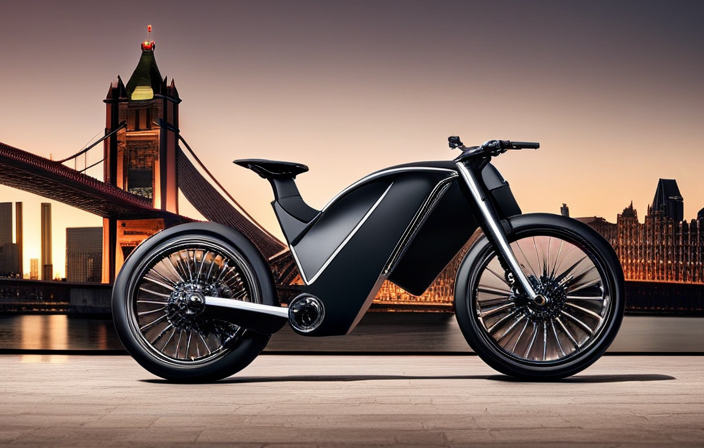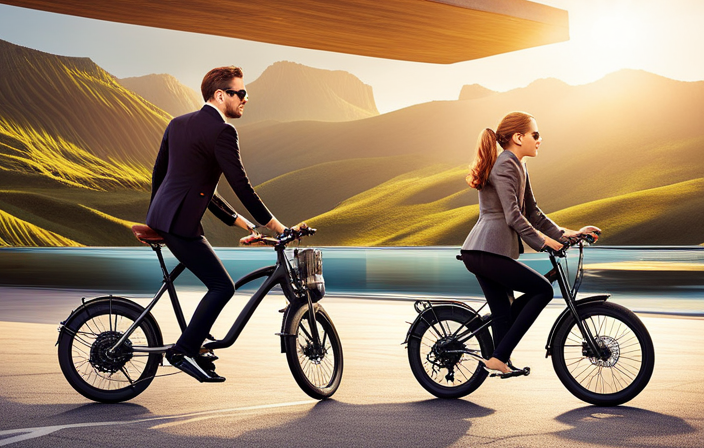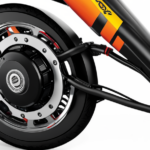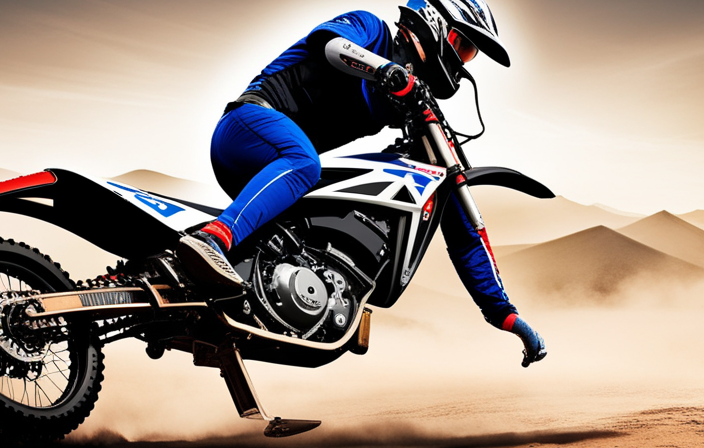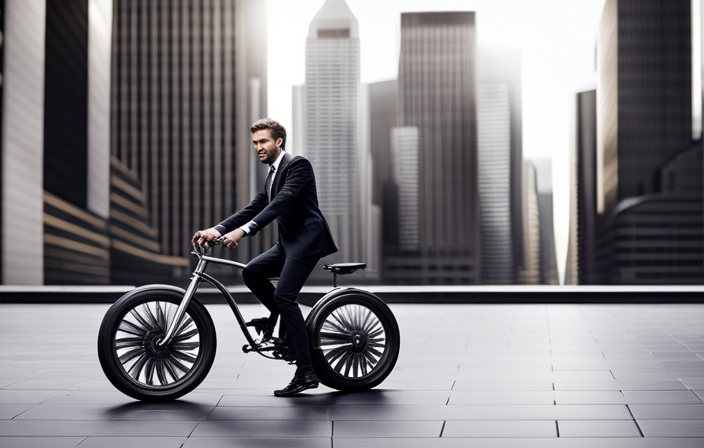As an avid cyclist, I’ve always been intrigued by the mechanics behind electric bikes. How do they work? What powers them? These questions have fueled my curiosity, leading me to delve into the world of electric bike technology.
In this article, we will explore the inner workings of electric bikes, from the motor that propels us forward to the battery that stores and supplies the energy. Join me on this analytical journey as we unravel the intricacies of how the electric bike works.
Key Takeaways
- Electric bikes have a battery and motor seamlessly integrated into the frame, with the battery located in the downtube or on the rear rack, and the motor located in the front or rear wheel hub or near the bottom bracket.
- The motor types can include brushless DC, geared, and direct drive motors, which determine the overall performance and efficiency of the bike.
- The frame of an electric bike is made of lightweight materials like aluminum or carbon fiber, which improves performance and maneuverability.
- Electric bikes utilize pedal assist systems and regenerative braking to enhance the riding experience, provide additional power while pedaling, and convert kinetic energy into electrical energy to extend the bike’s range and reduce brake pad wear.
The Basics of Electric Bike Technology
The electric bike works by using a battery to power the motor. Electric bike design is focused on integrating the battery and motor technology seamlessly into the frame.
The battery is typically located either in the downtube or on the rear rack, depending on the specific model. The motor is usually located in the hub of the front or rear wheel, although some electric bikes have a mid-drive motor positioned near the bottom bracket.
The motor technology varies, with some electric bikes using a brushless DC motor, while others utilize a geared motor or a direct drive motor. These motors provide the necessary torque to propel the bike forward.
The motor, powering your ride, plays a crucial role in determining the overall performance and efficiency of the electric bike.
The Motor: Powering Your Ride
To power your ride, you’ll need a motor that gives you the speed and torque you desire. The motor is the heart of an electric bike, responsible for converting electrical energy into mechanical power. When choosing a motor, it’s important to consider factors like motor efficiency and durability. Here are five key aspects to consider:
-
Motor Efficiency: Look for a motor that maximizes energy conversion, ensuring that the battery power is efficiently transferred into forward motion.
-
Motor Size: Consider the size and weight of the motor, as it can affect the overall performance and maneuverability of the electric bike.
-
Motor Type: Choose between hub motors, which are integrated into the wheel, or mid-drive motors, which are located near the bike’s bottom bracket.
-
Torque Output: A higher torque rating allows for better acceleration and climbing ability.
-
Motor Cooling: Opt for motors with effective cooling systems to prevent overheating and extend motor durability.
Now, let’s delve into the next section about the battery: storing and supplying energy.
The Battery: Storing and Supplying Energy
When it comes to the battery, you’ll need to understand how it stores and supplies energy. The battery in an electric bike is responsible for providing power to the motor, allowing you to ride without pedaling. It stores electrical energy in chemical form and converts it into mechanical energy to power the motor.
The storing efficiency of the battery determines how much energy it can hold and deliver to the motor. Higher storing efficiency means longer rides without the need to recharge frequently. Energy consumption is another important aspect to consider when it comes to the battery. Efficient use of energy ensures that the battery lasts longer and provides a smoother ride.
Understanding the battery’s storing efficiency and energy consumption is crucial for maximizing the performance and range of your electric bike.
Now, let’s delve into how the pedal assist system works.
Pedal Assist: How it Works
Pedal assist, also known as PAS, is a feature that enhances your riding experience by providing additional power while you pedal. This feature comes in different types, including cadence sensor, torque sensor, and pedal torque sensor. The cadence sensor measures how fast you are pedaling and provides a corresponding amount of power. The torque sensor measures the force you apply to the pedals and adjusts the power output accordingly. The pedal torque sensor combines the benefits of both sensors by measuring both cadence and torque simultaneously.
The advantages of pedal assist are numerous. It allows you to ride longer distances with less effort, especially on uphill climbs. It also provides a smoother and more natural riding experience. Additionally, pedal assist helps to reduce strain on your joints and muscles, making it suitable for people of all fitness levels.
With a good understanding of how pedal assist works, let’s move on to the next section about regenerative braking: harnessing energy.
Regenerative Braking: Harnessing Energy
You can harness energy through regenerative braking, which allows you to capture and store power generated during braking for later use. This technology enhances the energy efficiency of electric bikes by converting the kinetic energy produced during deceleration into electrical energy.
The braking system of an electric bike consists of sensors that detect when the rider applies the brakes. When the sensors detect braking, the electric motor switches into generator mode, converting the rotational energy of the wheels into electrical energy, which is then stored in the bike’s battery.
This process not only helps to extend the range of the electric bike but also reduces the wear and tear on the brake pads. Moreover, it promotes a more eco-friendly mode of transportation by minimizing energy waste.
Transitioning into the subsequent section about ‘electronic controls: managing speed and performance,’ the regenerative braking system is just one example of how electric bikes utilize advanced technologies to enhance their overall functionality.
Electronic Controls: Managing Speed and Performance
To manage speed and performance, you can adjust the electronic controls on your electric bike. These controls allow you to fine-tune the power output and optimize the overall performance of the bike. By managing power, you can increase or decrease the assistance provided by the electric motor, depending on your preferences and needs. This allows you to conserve battery life and extend your riding range. Additionally, the electronic controls enable you to adjust the speed limits of the bike, ensuring that you stay within legal limits and ride safely. They also play a crucial role in providing a smooth and seamless transition between pedal-assist modes. By effectively managing power and optimizing performance, you can have a more enjoyable and efficient riding experience. Moving on to the next section about ‘frame and components: built for efficiency’, we will explore how these factors contribute to the overall functioning of an electric bike.
Frame and Components: Built for Efficiency
When choosing an electric bike, it’s important to consider the efficiency of its frame and components. An electric bike with an efficient design and lightweight materials can greatly enhance its performance and overall riding experience.
The frame of an electric bike is typically made from aluminum or carbon fiber, both of which are known for their strength and lightness. These materials help to reduce the overall weight of the bike, making it easier to maneuver and providing a smoother ride.
Additionally, the components of an electric bike, such as the motor, battery, and drivetrain, are strategically placed to optimize efficiency and reduce energy loss. By maximizing the efficiency of the frame and components, electric bikes are able to provide longer battery life and improved performance. This ensures a more enjoyable and efficient ride.
Moving forward to maintenance and care: keeping your electric bike in top shape, it is important to properly maintain your bike to ensure its longevity and optimal performance without compromising safety.
Maintenance and Care: Keeping Your Electric Bike in Top Shape
Properly maintaining and caring for your e-bike is crucial to ensuring its longevity and optimal performance. To keep your electric bike in top shape, it is important to follow proper cleaning techniques.
Regularly clean the frame, wheels, and components using a mild detergent and water. Avoid using high-pressure water as it can damage sensitive electrical parts.
Additionally, lubricate the chain and gears regularly to prevent rust and ensure smooth operation.
In case of any issues, troubleshooting common problems like battery charging, motor assistance, or display malfunctions is essential. Refer to the user manual or contact the manufacturer for specific troubleshooting steps.
By properly maintaining and troubleshooting your electric bike, you can enjoy its benefits of eco-friendly transportation.
Benefits of Electric Bikes: Eco-Friendly Transportation
The benefits of e-bikes include being an environmentally friendly mode of transportation. They offer a sustainable commuting solution that reduces carbon emissions and helps combat climate change. With electric bikes, you can minimize your carbon footprint and contribute to a cleaner, greener environment.
Markdown bullet list:
- Lower carbon emissions: Electric bikes produce zero emissions during operation, reducing air pollution and improving air quality.
- Energy efficiency: E-bikes are more energy-efficient than traditional vehicles, making them a sustainable choice for transportation.
- Reduced dependency on fossil fuels: By opting for electric bikes, you can decrease your reliance on non-renewable energy sources and promote a more sustainable future.
By choosing an electric bike as your mode of transportation, you can enjoy the benefits of eco-friendly commuting while reducing your impact on the environment. Now, let’s move on to the next section and explore how to choose the right electric bike for your needs.
Choosing the Right Electric Bike for You
To find the perfect electric bike for your needs, consider factors such as your preferred riding style, desired range, and budget.
When choosing the right electric bike for your needs, there are several important factors to consider.
First, think about your preferred riding style. Are you looking for a bike for commuting, off-road adventures, or leisurely rides? This will help determine the type of electric bike that is best suited for you.
Next, consider the desired range of your bike. How far do you plan on riding in a single charge? This will help determine the battery capacity and motor power that you require.
Lastly, think about your budget. Electric bikes can vary greatly in price, so it’s important to find one that fits within your financial means.
By considering these factors when buying an electric bike, you can ensure that you choose the right one for your needs.
Frequently Asked Questions
What are the different types of electric bike motors available?
There are three main types of electric bike motors: hub motors, mid-drive motors, and friction drive motors. Each has its advantages, such as the hub motor providing a smoother ride, the mid-drive motor offering better hill climbing capabilities, and the friction drive motor being more lightweight.
How long does it typically take to fully charge an electric bike battery?
Typically, it takes a few hours to fully charge an electric bike battery, depending on its capacity. The charging time is like waiting for a flower to bloom, but once it’s done, you’re ready to ride.
Can I ride an electric bike in the rain?
Yes, you can ride an electric bike in the rain. However, it is important to adjust your riding technique and perform proper maintenance to ensure safety and longevity of the bike.
Are electric bikes legal to ride on public roads and bike paths?
Yes, electric bikes are legal to ride on public roads and bike paths. However, there are specific electric bike regulations and safety guidelines that must be followed to ensure safe and responsible riding.
How much weight can an electric bike typically carry?
An electric bike’s cargo capacity determines the weight it can carry. Weight distribution is crucial to maintain balance and stability. Think of an electric bike as a trusty packhorse, ready to carry your load efficiently and safely.
Conclusion
In conclusion, the electric bike is a marvel of modern technology. Its motor, powered by a battery, propels you forward with ease and efficiency. The pedal assist feature seamlessly combines human power with electric power, giving you the best of both worlds.
And let’s not forget about regenerative braking, which not only helps you slow down but also harnesses energy. With its sleek frame and components designed for efficiency, the electric bike is a true engineering masterpiece.
By choosing the right electric bike, you can enjoy eco-friendly transportation while keeping yourself in top shape.
